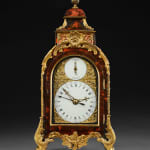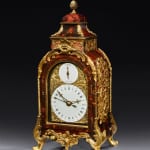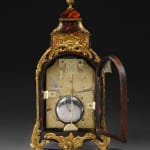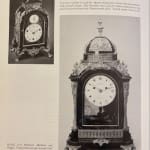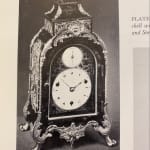MARRIOTT. AN EXCEPTIONAL TURTLE SHELL QUARTER CHIMING TABLE CLOCK
H: 38cm / 15"
Further images
Provenance
Private Collection: London, UKLiterature
R. C. R. Barder, The Georgian Bracket Clocks 1714 – 1830 (Suffolk: The Antique Collectors' Club, 1993), pl. V/13, for a nearly identical clock by James Cox and Son
Lian Ying, Clocks and Watches of the Qing Dynasty from the Collection in the Forbidden City (Foreign Languages Press, 2002), p. 113, for an almost identical ormolu-mounted turtle shell case
A fine and rare mid-18th century English table clock, veneered in turtle shell and mounted with ormolu, featuring a 24-hour enamel dial with centre seconds and quarter chiming movement, made for the Chinese market.
The caddy top surmounted by a pine cone finial above ormolu mounts of scrolling foliage. The sides feature apertures backed in red silk and overlaid with finely pierced scroll frets, while the arched front door is edged with a gilt liner. The case rests on elegant scroll feet.
The 3.75-inch white enamel dial is marked with double chapters: Roman numerals I to XII and Arabic numerals 0–60 in five-minute divisions, each repeated twice. It retains finely cast gilt hands and an arrow-shaped centre seconds hand. Above is a dial allowing selection between strike and silent modes. Both dials are framed by gilt C-scrolls adorned with foliate and shell motifs.
The twin gut fusee movement is constructed with shouldered plates joined by five knopped pillars, each plate cast with the letter “M” (possibly for Marriott). The going train features a knife-edge verge escapement, while the strike train sounds the hours and quarters on two bells, struck by hammers mounted on the backplate. The backplate is finely engraved with a central basket of flowers above the maker’s signature, set within an elaborate cartouche of scrolling foliage and floral sprays.
Clocks Made for the Chinese Market
This mid-18th century English table clock belongs to the rare and culturally significant category of horological works created specifically for the Chinese market - objects that exemplify the convergence of mechanical sophistication, visual spectacle, and global trade in the Georgian era.
The clock reflects the influence of James Cox, the enterprising London jeweller and goldsmith who became the leading figure in the production of elaborate export clocks and automata for the Chinese and other Eastern markets. Although not a clockmaker himself, Cox employed many of London’s finest craftsmen to realise his extravagant designs, combining technical ingenuity with theatrical presentation. His success in China, particularly at the court of the Qianlong Emperor, set the standard for export clocks and inspired a generation of London makers to emulate his approach—incorporating musical and chiming complications, multiple dials, automaton features, and richly decorative cases tailored to Chinese tastes.
The present clock bears several hallmarks of Cox-inspired manufacture, notably its twin fusee movement, knife-edge verge escapement, and quarter-chiming bells—all characteristic of high-grade export clocks of the period. The backplate is finely engraved and marked with the letter “M”, possibly referring to Marriott, a documented London maker known for producing luxury chiming clocks for the Chinese market. Like Cox, Marriott operated within the network of export-focused workshops that supplied finely crafted clocks to the East India Company and private agents trading through Canton.
This clock exemplifies a moment of remarkable cross-cultural exchange, where English horological innovation met Qing imperial taste, resulting in objects that were as much instruments of diplomacy and wonder as they were timekeepers.





